Late 1996, I resigned from Colossal Pictures, the only full time staff position I’d ever had. By then I’d been working in animation for 15 years, but recent job disasters had soured me to the industry, and I was unsure what to do next. After traveling for a few months, I’d decided to focus on the enjoyable aspects of being a cartoonist by creating some projects of my own, and by February 1997 I came back to San Francisco to draw. Although my plan was to save money by working at my kitchen table, Robert Valley suggested that I sublet some space at an animation studio he’d founded in 1995. I did, and it represented a turning point in my creative life.
 |
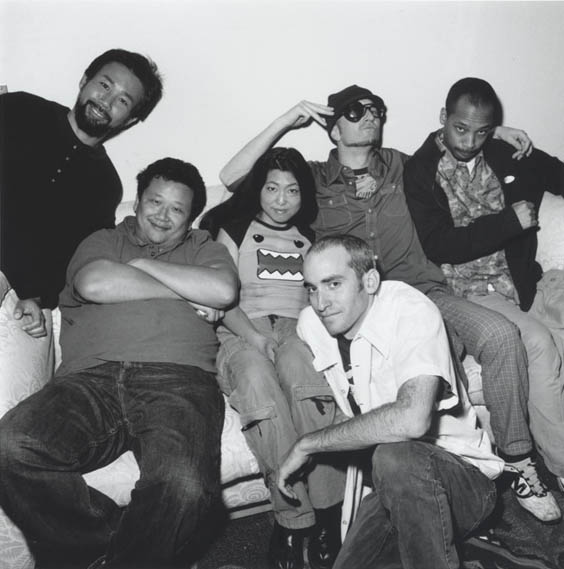 |
For several months I didn’t think about paid work, but came up with silly characters and goofy situations for them to be in. I’d recently created some characters for a company and loved the creating part, but the process of getting it made wasn’t a fun experience at all. To rekindle the joy I once felt at being a cartoonist, I resolved to make something primarily for fun. My own thing, not tied to schedules, budgets and the whims of others. I started doodling in the solo medium of comics, and gradually, I began enjoying drawing cartoons again. ROCKET RABBIT, SEPHILINA, and many other personal projects, were all born out of this period of play.
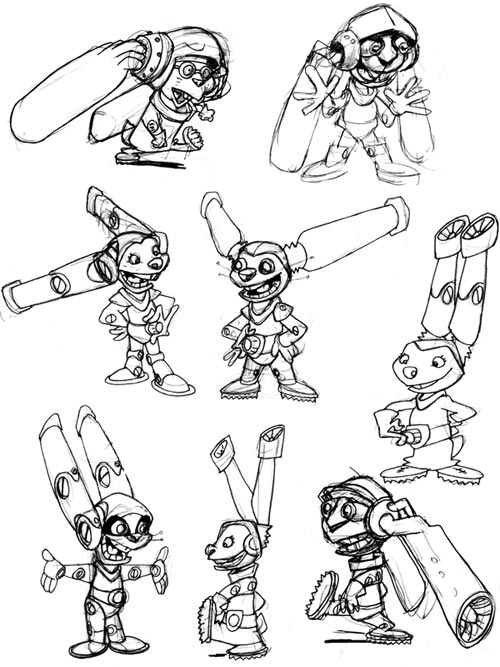 |
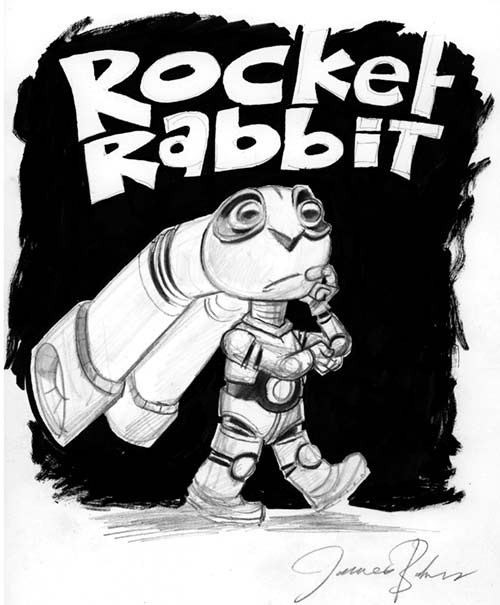 |
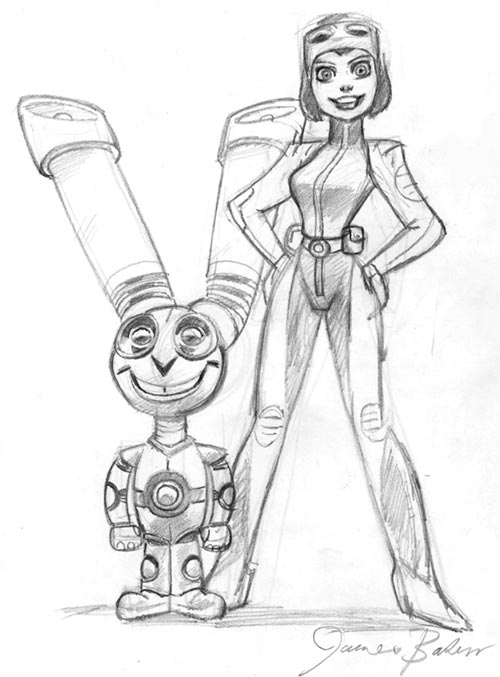 |
At around the same time, more freelancers moved in to Robert’s studio; Bosco Ng, and Steward Lee, two more colleagues from our Colossal Pictures days. Maverix slowly became a shared workspace for a loose collective of freelance artists, each working on their own professional or personal projects, while sharing resources and sometimes collaborating on certain jobs, and my American freelance career had begun. More artists joined; Sho Murase, Derek Thompson, Vaughn Ross, and Robert’s brother, John. I’d been on staff continually since arriving in the USA, but once Maverix became my base of operations I could try my hand at a variety of different projects at many different studios, both in San Francisco and Los Angeles. Following various leads (from ex-Colossal Pictures colleagues) I worked for ILM (‘Frankenstein‘) Pixar (‘Finding Nemo‘) PDI (‘Tusker‘) and on various commercials and shorts projects at Wild Brain.
The balance between my career, private life, and personal projects had always been hard to manage. When working in a professional studio, I’d get wound up in the cogs of production and think of nothing else but my job, but working at home as a freelancer didn’t give enough structure and I’d waste my downtime. At Maverix Studios however, I had the freedom of a freelancer with the routine and inspiring camaraderie of a studio, allowing me to do my personal projects for the first time. The studio changed its spelling from MaveriCKS (initially named for the NorCal surf spot) to MAVERIX, to mark the transition from the commercial studio it once was to the collective it had become (besides, that domain name was available). Around 2000 we bought a shared G4 computer (the first time I’d ever used Photoshop) and soon after got a shared website:
Maverix at times became a hive of industry, that expanded from the core membership to include friends helping with various animation projects (commercials and the like) and this meant that it was often a raucous place to work, with loud music, people playing video games, a barking dog running around, and friends of friends dropping by with beers. It could be a difficult place to concentrate in, and ironically I sometimes had to work on my kitchen table at home simply to get away from the noise in my paid workplace, but it was always an energetic and inspiring place to brainstorm, despite those distractions. When we were buzzing with activity, we’d take breaks by playing video games. I remember those competitions fondly, even though I was the loser every time, and the brunt of good-natured smack talking that was a fun feature of these bouts of digital fisticuffs.
During a slow spell at the studio in early 2001, Bosco Ng, Derek Thompson, and I were sitting with nothing to do, and somebody suggested that we should each make a comic for that year’s Comic-Con and actually exhibit. We’d all been attending and submitting portfolios for years, but actually making something to sell had never occurred to us before. We were perhaps inspired by the recent example of a colleague from ILM, Steve Purcell, who had a Comic-Con table the year prior to sell his own artwork. We decided to do something similar ourselves and just make something for a change, instead of getting raked over the coals by snotty art-directors at portfolio reviews. Many times throughout my career, in eager beaver conversation in pubs or coffeeshops, such notions had been mentioned before (“let’s make an animated short!” etc) but this was the first time we followed through, and made the things we said we’d make: three separate comic books.
 |
 |
 |
We knew nothing about printing or exhibiting, but it was remarkably easy to exhibit at Comic-Con in 2001; there was no waiting list, and in February 2001 we booked a table for July that same year, which would be unthinkable now. We’d committed to exhibiting and the ensuing period of making stuff remains one of the most pleasant stretches of several months in my entire career. Each day, the three of us would come in to the studio, jazzed to draw our comics, excited about what we were each doing, and what the other two guys were doing too. My effort was NERVE BOMB (my first Rocket Rabbit book) Derek made BINDU (a collaboration with Brian McDonald) and Bosco made METALUSION. We got them printed just in time. It is quite common for a group of artists to self publish these days, but it wasn’t as common back then, and we got a good reaction simply because of the novelty of a booth containing three artists selling their own stuff. A high point was when Mike Mignola visited our table and bought our books.
I got a rude shock when I finally got my bill from the printer. I’d cut the print deadline very close, and asked the printer to ship a few hundred of my comics expedited direct to San Diego, so they’d make the convention deadline, and ship the remaining 1800 books to San Francisco, at regular rates. They instead sent ALL the boxes to San Diego. The bill for expedited international shipping (from Canada) for 2,000 books was brutal. As that last minute transaction had been all arranged on the phone, I had no paper trail as to who said exactly what & when, so when the printer sicced a collection agency onto me I had to pay up. This was my first lesson that getting things printed was often the sour note in self publishing..
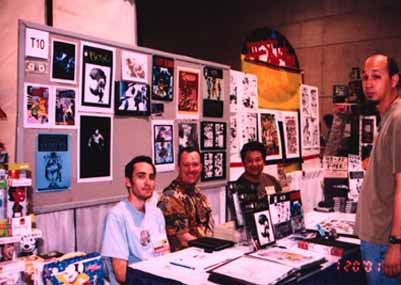 |
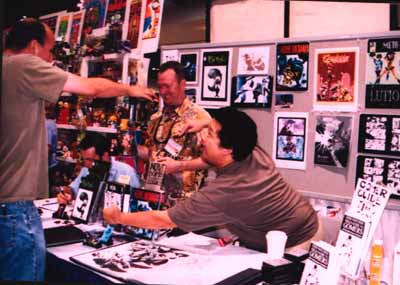 |
The next few years saw all Maverix members exhibiting their own projects at Comic-Con. There was the annual drama of getting various personal projects drawn and printed in time for the show, shenanigans with printing companies, Kinkos, or ink-jet printers. Hare-brained money-saving schemes to drive to the Con, all Maverix members crammed into a rented van, like the Scooby Doo gang or some lame rock band. Several years of fumbled bookings in shitty San Diego hotels, and assorted shenanigans; Robert accidentally drinking Sho’s contact lenses (twice) or getting stranded in Tijuana without his passport. Oh, such tales could be told (and might be one day.)
 Maverix was a chaotic band of loons that nevertheless helped me break the cycle of my own creative lameness. I am not sure why it took me so long to actually make something of my own, except that when younger, I had no idea how to get things printed or made. Researching the means of production wasn’t easy in the 80s and 90s, and it’s only relatively recently that those technologies have been accessible to your average Joe & Jane. Even so, I deeply regret not getting off my arse many years earlier and making something. Anything. I always thought about it, but somehow had the feeling that I needed permission or validation from someone else to move forward. The younger generation of artists today do not make that mistake, and self publish books and make short films right out of school. This is definitely the way to go. When you’re young and before you have a family, you should make stuff of your own as much as you can, as personal projects are the gymnasium where professional artists get to train their creative muscles and stretch themselves.
Maverix was a chaotic band of loons that nevertheless helped me break the cycle of my own creative lameness. I am not sure why it took me so long to actually make something of my own, except that when younger, I had no idea how to get things printed or made. Researching the means of production wasn’t easy in the 80s and 90s, and it’s only relatively recently that those technologies have been accessible to your average Joe & Jane. Even so, I deeply regret not getting off my arse many years earlier and making something. Anything. I always thought about it, but somehow had the feeling that I needed permission or validation from someone else to move forward. The younger generation of artists today do not make that mistake, and self publish books and make short films right out of school. This is definitely the way to go. When you’re young and before you have a family, you should make stuff of your own as much as you can, as personal projects are the gymnasium where professional artists get to train their creative muscles and stretch themselves.
Maverix became known as a fun place to hang out. The studio was not far from San Francisco’s South of Market club scene, and would often serve as a staging area for night club away teams, and after-parties. There were themed movie nights (“Ape Night” or “Monster Night”) or we’d simply gather to watch the latest anime blockbuster or foreign hit film on Bosco’s groovy projector. Maverix knew how to throw a very fun party on any pretext at all, and members of other bigger studios would all mingle on our common ground.
On the fateful day of September 11, 2001, I was the only person working at Maverix. This was before the era of carrying the internet in your pocket, and I was unaware of the world-changing attacks on The World Trade Center. I walked into work early that morning, and assumed that the police vehicles surrounding City Hall were there for another episode of ’Nash Bridges’, and continued to the studio, where I was working on paper and therefore not connected to the internet. By mid-afternoon, no one else had come to work but I didn’t think much of it, because Maverix was the kind of place where people kept odd hours. Later in the day, I went out to get something to eat at a nearby deli, where the the radio broadcasted something hectic in Korean. The guy making my sandwich was agitated about something in New York, but didn’t speak clear English, and I assumed it was a sporting event. After I walked all the way back home at about 11PM that night and turned on my TV, I finally saw the nightmarish images of airplanes dissolving into the Twin Towers. It still took 20 minutes for it to sink in that this was NOT a movie. That this was real. For the next 24 hours I stayed glued to the TV trying to make sense of it all. Al Qaeda who? Osama Bin What? Why?
 |
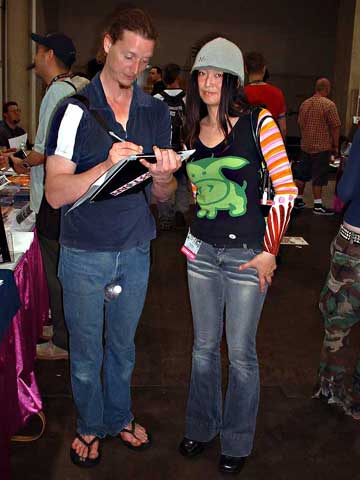 |
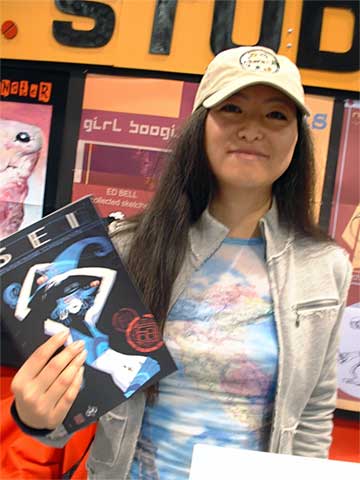 |
My girlfriend at the time was in Europe traveling with her family, stranded by the USA flight ban imposed in the wake of the attacks (for everyone other than the fleeing Bin Laden family). It was a stressful and gruesome time. At the national level there was great distress, but many things in my own life started to fall apart after 9/11. Freelance work started to dry up almost immediately, and most of my friends were out of work for a long time. As the disasters stacked up – political, personal, professional, financial, psychological – it was almost comedic, like a sequence from a movie where a shlub (a Jerry Lewis or a Jim Carrey) is subjected to one humiliating pitfall one after the other, to teach him ‘a lesson’. The difference being that everyone was experiencing this spiral of disaster at the exact same time. For me this grim period culminated in a bitter break up with my girlfriend in September 2002, leaving me dejected about life in America, about relationships, about work, and human beings in general. It took several years to find my optimism again.
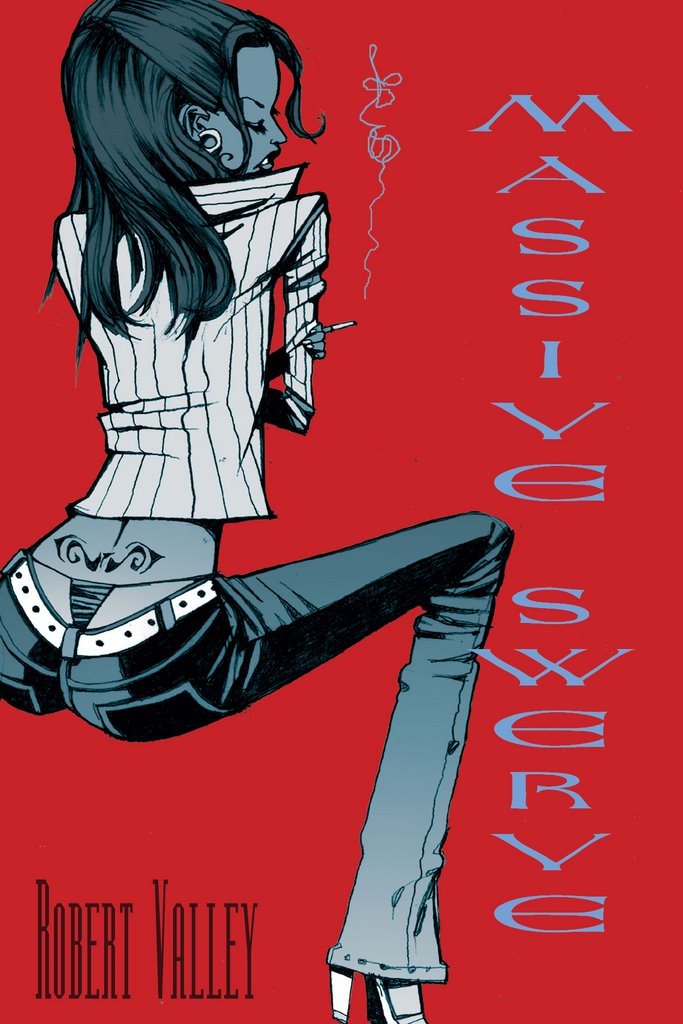 The original 9th Street address of Maverix Studios was in a seedy part of town. My memories of Maverix itself are overwhelmingly positive, but any negative memories come from that low-rent tawdry neighbourhood, rife with petty crime and scuzzy ne’er do wells prowling about. I had two different bikes stolen from inside the studio itself within three months, and I wasn’t the only Maverix member to have issues with theft. There was a strange ecosystem of Fury Road shantytowns in the alley behind the studio near our dumpsters, ruled over by a semi psychotic Hobo Warlord in camouflage combat pants, stripped to the waist. This methed-up alpha hobo was known to us as ’Hatchet Man,’ because we’d often see him out our back window flexing his muscles and practicing tossing his tomahawk into a telephone pole; wzzzz THUD! We’d have to thread our way gingerly past Immortan Joe and his underlings to put stuff in our own dumpster.
The original 9th Street address of Maverix Studios was in a seedy part of town. My memories of Maverix itself are overwhelmingly positive, but any negative memories come from that low-rent tawdry neighbourhood, rife with petty crime and scuzzy ne’er do wells prowling about. I had two different bikes stolen from inside the studio itself within three months, and I wasn’t the only Maverix member to have issues with theft. There was a strange ecosystem of Fury Road shantytowns in the alley behind the studio near our dumpsters, ruled over by a semi psychotic Hobo Warlord in camouflage combat pants, stripped to the waist. This methed-up alpha hobo was known to us as ’Hatchet Man,’ because we’d often see him out our back window flexing his muscles and practicing tossing his tomahawk into a telephone pole; wzzzz THUD! We’d have to thread our way gingerly past Immortan Joe and his underlings to put stuff in our own dumpster.
The back alley shanty town would grow, and periodically the city would swoop in to roust the squatters, and steam clean their paste off the alley. Then another shanty would slowly re-assemble, only to be purged when it too became a festering sore. The City wanted to offset costs for these frequent cleanups, and clearly the hobos had no money, so The City would attempt to send US the bill for these cleanings. One time I was at home in the shower in my own apartment when there was furious rapping on the door, with an officious voice demanding; “Open up! City Trash Police!” (or some such). I opened the door in my bath towel to be confronted by a guy we came to call ‘The Garbage Nazi‘, an enforcer with the city who’d found a scrap of rubbish in the alley bearing my name and address, and this was to be the justification for a BILL from City Hall; if any of our trash was strewn about by the human racoons that lived in the alley (as it often was) we’d get hammered by The City for alley cleanup. There were already stiff penalties for not having a padlock on our garbage can. However the entire system broke down when the guys driving the garbage trucks and emptying our dumpsters wouldn’t put the locks back on after emptying our trash. Then our garbage cans became prime scavenging sites, and even impromptu porta-potties for Hatchet Man and his homies (yes, not kidding).
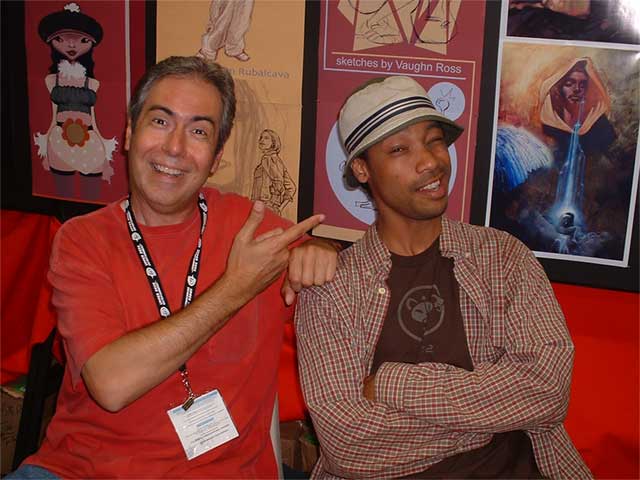 |
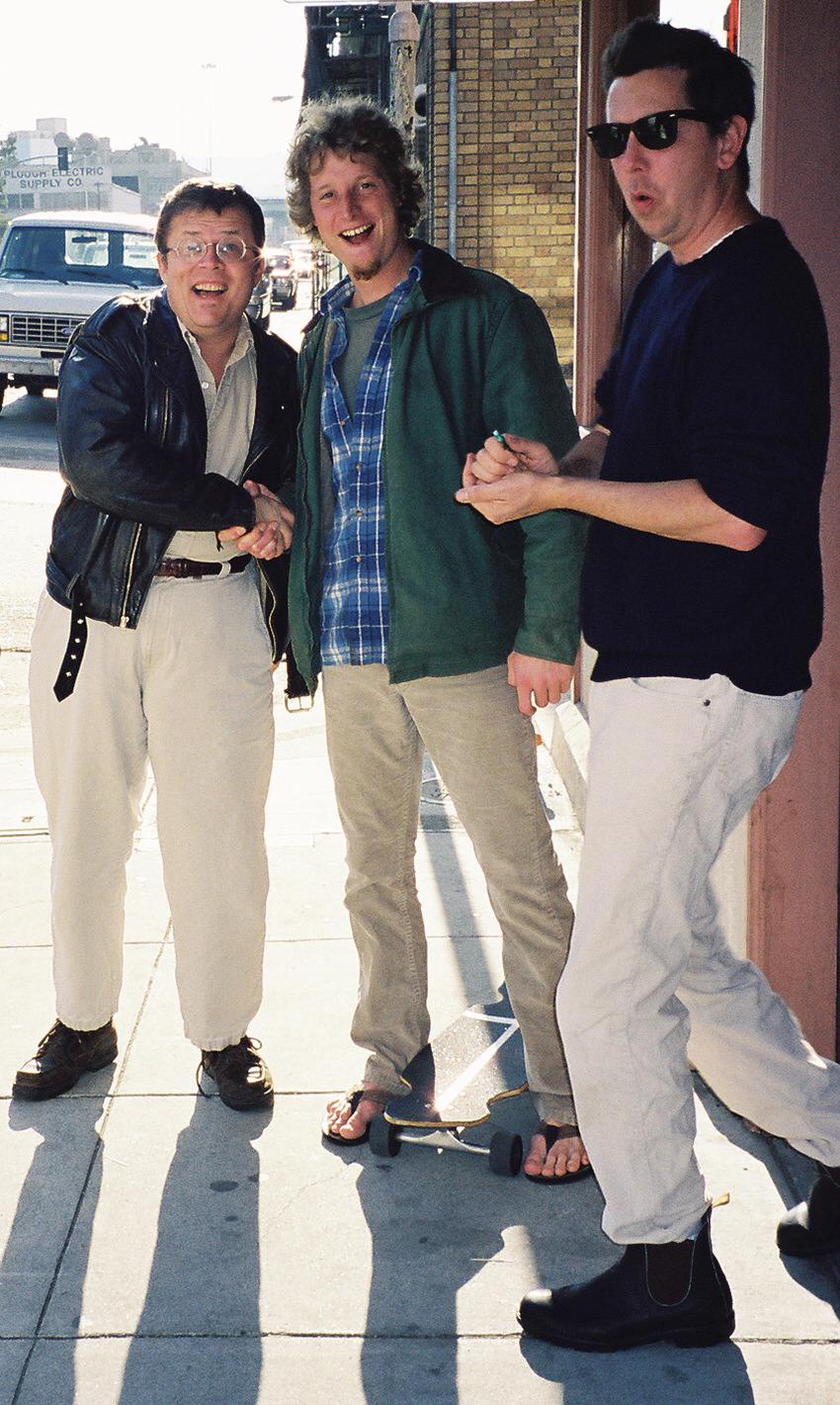 |
The initial draw to the area was cheap rent, when most businesses around us were fabric sewing sweat shops, likewise taking advantage of low costs. The first wave of internet start ups happened around that time, and when the tech boom hit the neighbourhood, suddenly those crappy sweatshops were turned into tech lofts and the area was awash with hipsters on scooters. But the .com boom of San Francisco wasn’t all glamour. Sometimes, when working late, we’d overhear tawdry transactions taking place in the medieval monkey cage in the back alley below the studio. It’s a strange disconnect to be working on a child’s cartoon at 2 in the morning, when you hear some drunk tech-nerd stumble out of a nearby bar to haggle a drugs-for-sex swap with a hobo-junkie. This sleazy Blowjob Bartertown was an aspect of the SF tech boom not covered by WIRED magazine.
Maverix soon lost its lease due to the escalating crazy rents brought on by this .com boom, when our landlord suddenly wanted us to pay something like $10,000 a month for a space that cost less than $2000 a month previously, which was very indicative of the greed of that time. The combo of tawdry sleaze & crummy infrastructure and high prices was brutal (and became the problem with San Francisco in general). When it was time to renew our lease in 2003, we couldn’t afford to be in the area any more, so the studio moved to 17th street and the new space was infinitely better than the original place. By that time, some of the members chose to become a proper LLC company, and the loose collective dissolved, and I left Maverix (thinking that we could barely manage the studio trash cans, let alone file paperwork for an actual company). This separation was 100% amicable, it was simply that our different goals for the studio had changed. Although I was no longer officially a member, I still participated in many Maverix events, and often dropped in on my old studio mates. We are all still good friends to this day.
One of the things I was most happy to collaborate in were the Maverix charity art auctions. The first was held out of a desperate need to express our love and support for our friend Mike Murnane, who’d been brought low by a tragic accident. He required surgery but had no insurance, and thus no funds to cover his ballooning medical expenses. The broader Maverix community came together to generate money in the only way we knew how; by making and selling artwork. Organised in a matter of weeks, this first auction raised a significant amount of money, even though many of us were out of work ourselves at the time. It became the first charity fundraiser of many, and such auctions became regular events at the studio. People from Pixar, PDI, ILM, Wild Brain, Ghostbot, and other studios in the Bay Area all assembled for good times and good causes.
This was my first experience of artists doing what they do to raise money for charities without any goal of self-promotion. I have seen similar things since, but for me the Maverix auctions were always the best. They may not have raised the cash of bigger art auctions that came later, but they were always all-inclusive and immensely rewarding to be part of. Lately, I’ve had a visceral sense of what such fundraising activities can do for a person who’s been medically devastated, when I was a beneficiary myself (in 2013). Though the money is very welcome, I found the support from the community to be the real force for good.
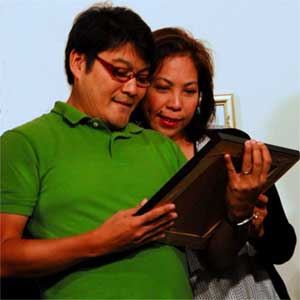 |
 |
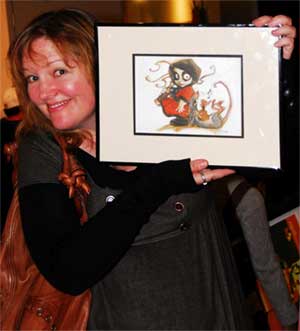 |
I’d recommend any freelance artists who work at home to find like-minded friends to share a workspace with, at least once in your career. In my opinion, an essential ingredient to make the whole thing work is a sort of rulebook (or ‘manifesto’ if you prefer) to ensure that the day to day nitty-gritty of bill paying and trash removal happens smoothly, and it it’s clear in everybody’s mind’s to what extent the studio is a workspace, and to what extent it is a fun space. If you can get those things mutually understood, this is one the most satisfying ways to work as a commercial artist.
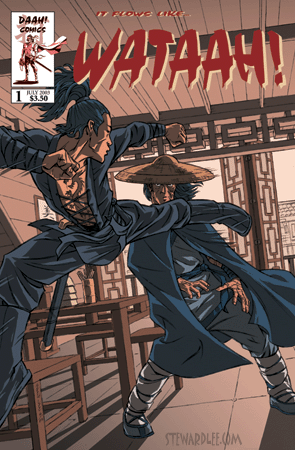 When I first fell in love with San Francisco in the early 1990s, the Bay Area had a healthy cross-section of big studios, medium-sized studios, and small studios. Over 25 years later, the middle of that ecosystem has died. There are still a few big places (impenetrable fortresses like Pixar, and ILM) and a few tiny studios too, but the mid-size studios are gone (perhaps because animated commercials are neither so common nor lucrative as they once were). Mid-sized studios were my favourite places to work, providing the bulk of the freelance jobs for people doing what I do, while taking more chances on younger talent than bigger studios. I miss these mid-sized studios a great deal. A lot of innovation is happening in the South Bay in GAMES, but my focus has always been on animation for broadcast or film, and in that respect San Francisco is not the vital town that it once was, sadly.
When I first fell in love with San Francisco in the early 1990s, the Bay Area had a healthy cross-section of big studios, medium-sized studios, and small studios. Over 25 years later, the middle of that ecosystem has died. There are still a few big places (impenetrable fortresses like Pixar, and ILM) and a few tiny studios too, but the mid-size studios are gone (perhaps because animated commercials are neither so common nor lucrative as they once were). Mid-sized studios were my favourite places to work, providing the bulk of the freelance jobs for people doing what I do, while taking more chances on younger talent than bigger studios. I miss these mid-sized studios a great deal. A lot of innovation is happening in the South Bay in GAMES, but my focus has always been on animation for broadcast or film, and in that respect San Francisco is not the vital town that it once was, sadly.
In 2011, MAVERIX STUDIOS finally closed its doors, marking the end for this fantastic collective of independent, Bay Area animation artists, though ex-members have gone on to work on many high-profile projects in a wide variety of media, from comics & games to film & TV. All members look back on the studio with fondness, despite some setbacks here and there. It was quite an achievement that such an unwieldy group of screwballs could operate so well for so long, during some very difficult years in the Bay Area media community, when many studios with ‘business plans’ and MBAs all went kaput. For many years I’d toyed with the idea of making some projects of my own, but it wasn’t until Maverix that I actually did it, and interestingly, it made me a more professional worker for others, when I had an outlet to do my own thing. Becoming a self publisher led to exhibiting at comics conventions, which I did for about 10 years and got a lot of satisfaction from. Being a member of Maverix Studios remains one of the most fruitful periods of my career.
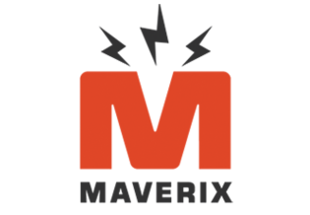
Founders of the Maverick commercial animation studio: Robert Valley Jeanne Reynolds.
Initial members of the Maverix Studios collective: Robert Valley, John Valley, James Baker, Steward Lee, Bosco Ng, Sho Murase, Vaughn Ross, Derek Thompson.
The 3rd wave: Tom Rubalcava, Osamu Tsuruyama, Tony Stacchi, Sergio Paez, Ted Mathot, Chris Petrocchi, Garett Sheldrew, Ed Bell.
Other friends who collaborated, or hung out: Patrick Awa, Mike Murnane, Gennie Rim, Granger Davis, Lyla Warren, Charlie Canfield, Dan McHale, Chris Carter, Charlene Kelley, Victor Gascon, Sam Hood, Dedan Anderson, Joel Hornsby, Jamal Narcisse, Lance Hughes, Ken Kaiser (and many more!)

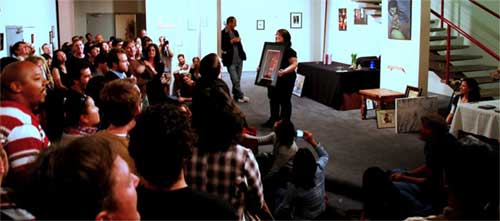
Jamie, a really enjoyable read 🙂
Thanks, ashley.
Thanks James, I’m always interested in your stories
Thanks for reading and commenting Marg!
This is fascinating, Jamie! I love learning about the history of Maverix and your involvement. I participated in one auction and still use an image from that donated painting as my logo. That was an amazing place that brought great people together for good things.
I’m glad it felt that way from the ‘outside’ because I always felt Maverix was that way from the ‘inside’. Thanks for commenting, Nadine.
I’m glad to have participated in the tail end! It was a fun place to work
It was! Completely screwy at all times, but full of good folks trying hard.
a lovely expression and reflection …and a flood of fond memories…thnx jamie !
Mighty Derek! My Maverix Homey! That time was a great coming together of so many talented & lovely folks. I was glad to be a part of it.
Wish San Francisco was as artist friendly as it used to be. So glad you have documented Maverix. Sounds so amazing. As someone who worked in total isolation from 2000-2008, having a place to go to to make work really hits home for me.
Maverix came along at exactly the right time for me, giving me inspiration and camaraderie that I really needed..
But what I also really love about what you mention in your essay is the need for artists to make their own personal work. Most of us spend all of our time dedicating ourselves to being useful craftspeople to a company. At some point we become depleted. It’s so great that you had this opportunity and that it happened with fellow artists. What a cool thing.
Yes. I’ve tried to maintain that balance between personal and professional creative work ever since. Prior to Maverix, I was 100% a company grunt all the way.
I’m just so grateful to finally be reconnecting with that inner spirit. Wish I had met all of you maverix back then.
Fun to read the history, Jamie. Took me back to all those great events and wildly creative people.
Thanks for reading and commenting, Steve. The 1990s/early 2000s was a very fun and creative time to be a freelancer in the Bay Area, when The animation scene had a really great sense of community. In hindsight it was probably the abundance of animated commercials that was the lifeblood of so many little places back then.
The best part were the mini-Maverix-Con to pick up the artist created books and those amazing Auctions and Parties.
Maverix was a screwball mess at many things, but really knew how to PAR-TAY.
Awesome parties!!!😃
Yes! The parties, auctions and movie nights were epic.
I have a distinct memory of attending a most enjoyable “film night” at Maverix Studios sometime in the late 1990s — but not sure exactly what it was, though — Jackie Chan? Kurosawa? Miyazaki? Sergio Leone? In any case — something way cool!!!
Could have been ‘all of the above’! I remember quite a few movie nights where we managed to watch multiple movies. My favourite was ‘Ape night’ Where we watched APE themed movies from around the world (France, Japan, USA)
Pretty sure it was “Army of Darkness”!
That sounds right. We saw so many great movies at Maverix. NIGHT WATCH (a Russian vampire movie) and the new (then)GAMERA were some stand out hits.
Thanks for writing this Jamie. Maverix was like 90’s Hip Hop. Wild, crazy, inventive and inspiring. Loved that place and love you guys.
Hey Jamal! Yeah it was a special time & place, full of good people. Glad that you were part of it!
Maverix was so awesome. I loved reading your recounting of those days. The artwork, camaraderie, productivity, auctions(!!)… all of it was fertile & unique! So glad I was able to glimpse some of those times with you guys. What a crew you were!! & How wonderful it went ’til 2011! 💥🎬🎨🎪🎯🏄🏽🎮💫⚡️Thx 4 writing & sharing, James!!👍🏽
Hey Mara! Thanks so much for commenting. Yeah, Maverix was a special place.
Man, this was a great post and a great read.
Definitely a fun place!
Right?
I am so glad I got to go to see some of the shenanigans AND “vanna” some auctions. Set me up to run auctions of my own! It was such a happy place with lovely and talented people. Great essay!
What a great essay! Took me right back to visiting the studio, and getting to “vanna” art for the auctions! Kicked off my whole auctioneering career! ❤️
That’s right! You were our Vanna White.
Fantastic read Jamie. I so appreciate the camaraderie, familial like support and creative motivation stirred on by this amazing community of artists and animators. I never worked on a Maverix project, but if I could go back in time, I’d certainly try to change that. Thanks for memorializing your experience.
Thanks for reading and commenting, Sandra. It was a fun little studio, mind you, there were many great little studios in the Bay Area back then.
Totally enjoyed your climb up the ladder.
Thanks, Mrs S!
Stew brought the wine
And Lance TOOK the wine.
And the bathroom key
Initially, he’d at least PRETEND he was dropping in at the studio because he liked us, then casually help himself to Stew & Mary’s booze. Eventually though, he’d just swoop in, grab a bottle and BOLT.
Maverix Studios definitely marked highlight in my late 20’s/early 30’s when I moved from Tokyo with no job nor connection in the industry. I was very lucky to be allowed to hung out there, to know all hungry yet tallented folks in Bay Area through you, Jamie. It was my last season to still be able to young with reckless abandon and I am profoundly grateful to be a small part of it in 2001-2002. Now all of ex-maverix are famous and successful except me:p
Pat! So glad you commented. I was very glad too that you were a part of the Maverix family at that time. I remember 2001/2002 as being a tough time, with all of us having difficulty with money and finding work, but the camaraderie of the studio was always great.
Great stuff, Jamie. Keep it coming. People will needing this history in years to come. cheers!
Thanks, Scott! Not really sure if there will be any great need for the history of a bunch of kooky loons, but glad if a few people like you get a kick out of it.
Love this slice of Bay Area Animation History. Thank you, Professor Baker!
You need to get a scribe to pen the Tales o’ Ghostbot.
We will hire YOU!!
ha! you need someone EMBEDDED with the troops, for that gritty gonzo journalism angle.
YEsss!!!!
Did you ever see the sty in all its glory?
i think i may have named that studio
Interesting factoid. I’d always assumed it was named by Robert.
no it was Tom, I remeber it clearly
Thanks for sharing, Jamie! What a great read! 🌟
Have you ever shared a freelance workspace, Charles? I’ve done it a few times, and It is great, if you can find the right people.
Not yet, Jamie. Always dream of having a good bunch of artists with similar visions here. The community is smaller here and I’m probably a bit weird myself – I’m also a bit paranoid with cost. 🤡 One day! One day!
I’ve been skyping/facetiming with people though! Do you use them? Would love to catch up with you one day!
Yeah.. the cost can be tricky during the slow spells for sure.. I use Skype very occasionally.
Sydney is getting more expensive these days.. 😔
Great history there James,
Sounds like it was a lot of fun back then, Yeah, the mid size studios were the best in those days. Not a fan of the modern behemoth enterprises of today.
Hey Arthur. Used to be if a small or mid-size studio folded, there’d be another one (or more) to form out of the pieces. For the past 10 years or so I’ve not seen that happening. Not sure why. I guess in the past clients were likely to go with a studio that was (somewhat) local, but these days the talent pool is truly global, and living in an expensive city automatically prices you out of the competition, whereas it used to be advantage (to be close to the ‘action’).
So the big behemoths are the only game going (if you can get in).
Those were some of the best times I’ve had in my career. My first job right out of College during a time unemployment was everywhere! I’m so glad Maverix took me in. And Thank YOU for mentioning me as a friend collaborator 🙂 You’ve reminded me that my creative spirit isn’t dead, and I’ve got great creative friends like you to encourage me. Just a few keyboard strokes away 😉 You never stop being a MAVERIX
Mav Pride, yo!
Dang dude! Sweet read. U hit the nail on the head with those descriptions of everything. Man do I miss those days. I feel the same way about Maverix.
It was a chaotic place, and always barely staggering along, month to month, but it was full of good people and fun times.
Definitely! The amount of creativity in that place was pretty awesome. One thing I wish I could do again, is to look through all that Frankenstein art that forever blew my mind.
I think Bosco might have a stash of some of that stuff?
Gotta it up the Bos!
Great story Jamie!! Love the photos too. I always loved hanging with the Maverix crew. I remember the Life drawing sessions and Crazy Taxi matches. Vic and Vaughn were working on the Anita Bomba series there for a bit and I had the opportunity to work with Rob and Stew on the Sony “Pass it on” commercials through Wild Brain. Still have my copies of Nerve Bomb (Rocket Rabbit) and Stew’s “Wattaaah”. Super fun times!!
Hey Ken! I forgot about Anita Bomba. Thanks for the reminder.
Very Cool Mr Baker, Great read!
Thanks Sarah. I’ll have to write about Hanna’s sometime.
Heck Yeah!! So many good times& stories ! 🙂
Including YOU on a runaway horse!
Those were some good times for sure!
“Sorry duuuude!”
Good times, thanks for the memories, Jamie!
thanks for reading Stew (and for providing so many of my great Mav memories!)
Powerful J Baker does it again! It was a fine creative brain trust. At times a comedy of errors, but sometimes a shining beacon❗️
Ha ha! very well put, Ed!
Great read, Jamie, thanx for sharing, lol …those were the good times!
Maverix was very special, I always remember fondly that spot. I was very lucky I was able to share space with such talented group. I learned a lot from you and all the fun bunch
I think we all felt the same way; lucky to be learning from a talented bunch of friends.
James, The Guys on Maverix is in the roster of a Studio called Ffake https://www.ffake.com/directors/directors.html
Don’t Know why Ffake didn’t make you in the Directors List
That list is only for directors who’ve worked for Ffake. I have never worked there.